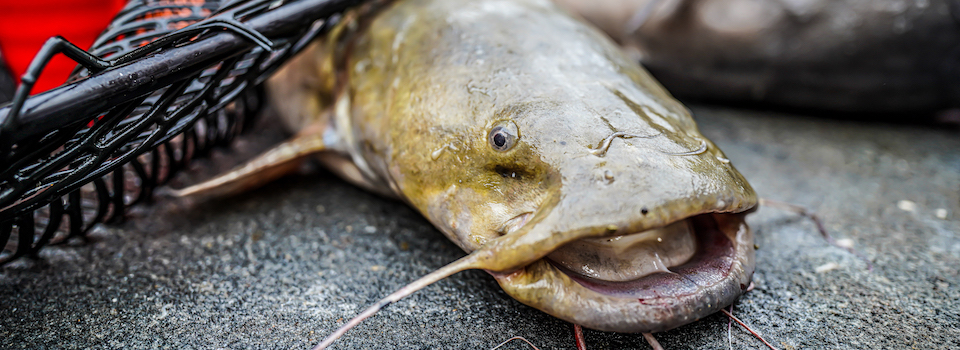
K-State fisheries and aquatics specialist Joe Gerken says catfish have the potential to grow large and yield a large amount of meat.
Gone Fishin’: Colder months signal new opportunity for anglers in Kansas
K-State expert says summer has ended, but not the fun of fishing
At a glance: Fish all year round, says K-State fisheries and aquatics specialist Joe Gerken. He explains how to approach fishing in colder months and the kinds of fish people are more likely to catch.
More information: Joe Gerken, 785-532-1418, gerkenje@k-state.edu
Related: Fins, Furs and Feathers podcast
Sept. 23, 2024
By Jacob Klaudt, K-State Research and Extension news service
MANHATTAN, Kan. – With Sept. 22 marking the last day of summer, many have covered up their pools and ended activities considered strictly for summertime recreation, including fishing. However, K-State fisheries and aquatics Extension specialist Joe Gerken says people may want to delay retiring their rods for the year.
“This is a fantastic time of year to be out on the water,” he said. “Many opportunities still exist in the fall, and everyone should also be excited for the winter fishing activities right around the corner.”
Listen to Joe Gerken on the podcast, Fins, Furs and Feathers, airing weekly on Agriculture Today
While leaf colors and temperatures change, so does fish behavior. Gerken said species like wipers and white bass stayed shallow and soaked up the sun in late August – a habit likely to change in later autumn months.
“As water temperatures decline, they (wipers and white bass) are going to start moving to deeper habitats, while becoming more aggressive,” he said. “It’s going to be some fun fishing out there.”
‘Aggressive’ fish tend to be more interested in a fisherman’s lure than usual due to their increased appetite, which experts attribute to the cold nature of the upcoming months.
“They will see bait fish swimming by or imitation bait fish and pursue them hard,” Gerken said. “They are going to be hungry, and that makes for easy fishing opportunities where you can catch large numbers.”
When waters become more frigid, Gerken said walleyes become the most prevalent fish in Kansas ponds and lakes after snapping out of their ‘lazy’ summer state.
“Walleyes are a cold-water species,” he said. “They will be more active, and people will have more chances to catch them shortly.”
According to Gerken, chilly weather conditions also make catfish more vigorous.
“It’s an exciting time of year to go out and go after some large flatheads, channels or big blue catfish,” he said. “Catching a lot of them will ensure you have plenty of meat in your freezer for the winter.”
Yet, people must alter their general fishing strategies for the fall. Gerken said fishermen should consider targeting more cold-water species and slowing their presentations.
“Fish are cold-blooded organisms,” he said. “They are only as warm as their surrounding environment, so fishing techniques will have to change and be more relaxed.”
Looking ahead, the Kansas Department of Wildlife and Parks annually stocks various bodies of water in Kansas with rainbow trout, which also become animated in November and December.
“They are another great option as long as you have a fishing license and a trout stamp,” Gerken said. “Without that stocking, you would not be able to see trout in Kansas because they cannot survive the warm water.”
When weather conditions allow and the time arises, Gerken also recommends ice fishing as an avenue for Kansans to drop a line in wintery waters.
“The biggest thing to remember is to check if the ice is safe before you go on it. It needs to be at least 4-6 inches thick,” he said. “If the ice is sturdy enough, it’s an awesome slow fishing technique.”
***

K‑State Research and Extension is a short name for the Kansas State University Agricultural Experiment Station and Cooperative Extension Service, a program designed to generate and distribute useful knowledge for the well‑being of Kansans. Supported by county, state, federal and private funds, the program has county extension offices, experiment fields, area extension offices and regional research centers statewide. Its headquarters is on the K‑State campus in Manhattan. For more information, visit www.ksre.ksu.edu. K-State Research and Extension is an equal opportunity provider and employer.